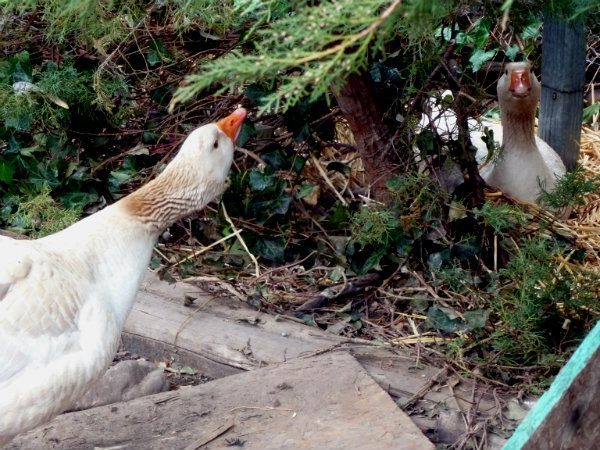
I came home from work yesterday to find our goose and gander* wandering around the yard as if they didn’t have any obligations in the world except to eat fresh green spring grass. Except they do have obligations: five big, beautiful eggs tucked into the goose’s straw nest under our bedroom window. Oh, but she wants to be a free woman. Well, missy, not today!
At the outset of this fowl project, Ben and I had intended to buy an egg incubator. That plan changed drastically when we turned to our guide, Dave Holderread’s “The Book of Geese: A Complete Guide to Raising the Home Flock” and his chapter on incubation. Here is what we read: artificially incubated goose eggs have the lowest hatchability of all poultry eggs. However, it is not unusual for a setting goose to hatch every fertile egg beneath her.
Under artificial incubation, the average hatchability of goose eggs falls between 55 to 75 percent of all eggs set, or 65 to 85 percent of the fertile eggs. The average fertility for light and medium-weight birds is in the range of 75-95 percent. With these kinds of odds, if we used an incubator we risked losing nearly half of our hatch. That being said, Holderread also notes that it’s notoriously difficult to usher even fertile goose eggs kept under the best conditions through to a successful hatch.
The goose seemed to be laying a new egg about every other day, sometimes every three. We found one egg in the chicken house. We found two or three in the awkward little corner we described in the last blog. We didn’t keep any of these for hatching. The first year of a goose’s life, writes Holderread, her first six to eight eggs are rarely fertile. So we tried eating them. I would describe a goose egg as tasting silky and creamy, without the grassy taste you can get from a free-range chicken egg. My mom savored the goose egg we gave her and called it “sweet.”
 It isn’t hard to tell a goose egg from a duck egg. The goose egg yolk is a much deeper shade of yellow, and the albumen is whiter, more opaque and less oily than the chicken egg.
It isn’t hard to tell a goose egg from a duck egg. The goose egg yolk is a much deeper shade of yellow, and the albumen is whiter, more opaque and less oily than the chicken egg.
Ben and I worried that the goose’s choice of a nesting spot was less than ideal. So we were relieved to find her one day preparing a new nest against the west facing side of our house under some bushes. It seemed a safe place, well protected from sun and weather, there was just one slight hang up: she’s taken to setting on a PVC-pipe stormdrain. Her next five eggs she placed in the new nest. We took them, cleaned them and kept them in a semi-regulated environment (regulated for temperature and humidity) in a camping cooler until she reached a number we thought she might set on.
Two days ago we brought the eggs out and placed them in her nest. She never even glanced in their direction. With news of snow and cold nights on the way we grew nervous. So today I took drastic measures. I barricaded her and her gander guard into the nesting corner with some sturdy wire fencing we found laying about – it’s a total farm around here, with spare stuff everywhere.
I called Ben and we talked for a bit about the birds and getting some hens to hatch the duck eggs – they also keep abandoning their nest. Our conversation over, I hung up, only to call him back immediately.
“She’s sitting on the nest,” I told him. “She’s moving straw around under her and the male is standing at attention protecting her.” With nowhere to go, it seemed our lady had quickly resigned to her fate.
 This is the ideal: a goose doing her duty on the nest and a gander protecting her.
This is the ideal: a goose doing her duty on the nest and a gander protecting her.
But, it seems I spoke too soon. This morning, with the snow blowing sideways and piling up lightly, I went outside to check on the mother- and father-to-be. Their parenting skills are apparently greatly lacking. She wasn’t on the nest and the eggs were covered in snow.
We’re kind of at our wits’ end here. If any of our readers have any advice, we’d love to hear it. We’re trying to encourage our silkie hen, the Missy, to go broody. We’ve placed her in a dimly lit and spacious (for a silkie) extra chicken hutch with food, water and a clutch of duck eggs. She’s reared a hatch before, so here’s hoping she can do it again.
* Ben will be posting a new blog in the next day or two explaining why we now only have one goose and gander. So stay tuned.
